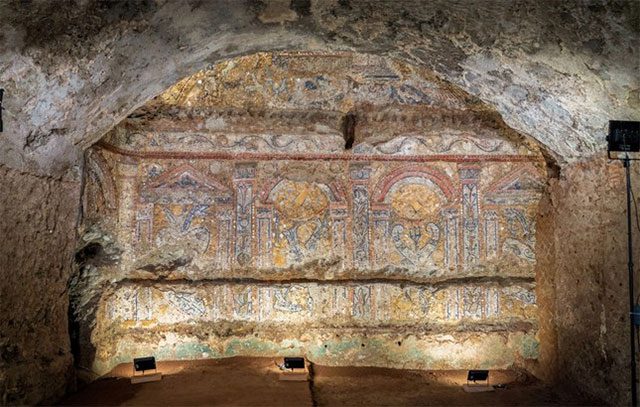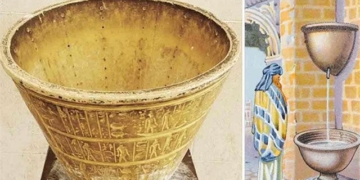A five-year excavation on the Palatine Hill of Rome yielded a treasure last week as archaeologists discovered a luxurious banquet hall dating back to the 1st or 2nd century BCE, notable for its large, intact, and vividly colored mosaic wall.
Estimated to be around 2,300 years old, this structure is part of a large noble residence located near the Roman Forum, which has been under excavation since 2018.

This 2,000-year-old shell cave was used as an outdoor dining area and features a large mosaic wall made with shells, coral, and brightly colored glass. (Photo: Emanuele Antonio Minerva/MiC).
Measuring nearly five meters long, the mosaic depicts vines, lotus leaves, tridents, trumpets, helmets, and mythical sea creatures, meticulously crafted using mother-of-pearl, shells, coral, precious glass fragments, and specks of marble. The artwork is framed with multicolored crystals, porous travertine stones, and unusual ancient Egyptian blue tiles.
Alfonsina Russo, the archaeologist in charge of the Colosseum Archaeological Park and the area, stated that what makes this discovery “one of a kind” is not only the remarkable preservation of the mosaic but also the decorative elements depicting scenes of naval battle celebrations.
The complexity of the victory mosaics surprised the project team. They depict a coastal town surrounded by walls with watchtowers and corridors—possibly an idealized or real location—situated atop a cliff crafted from travertine stones. Images of sailboats with billowing sails appear alongside depictions of mythical sea monsters devouring the enemy fleet.
Archaeologists are attempting to determine whether the delicate—and expensive at the time—coral used in the display came from the Mediterranean Sea or the Red Sea (the nearest and most commonly used oceans by the Romans for material extraction). The research team believes that a rare blue glass powder included in the design may have originated from the ancient city of Alexandria in Egypt.
Russo remarked, “In ancient times, when powerful noble families lived on the Palatine Hill, elaborate decorative elements were often used as symbols to express luxury and high social status.”
The room, which Russo considers a “gem,” is an outdoor banquet hall overlooking the garden that could be used in the summer for entertaining guests.
A complex space like this could also be used to impress visitors with water games, which were very popular among the elite at that time.
Marco Rossi, a professor of Roman antiquities and head of the mosaic laboratory at the Università degli Studi di Roma Tre, pointed out that these summer banquet halls served not only as relaxation spaces but also as displays of wealth and social class.
Rossi added that discovering a complete wall mosaic is extremely rare, especially since these pieces are more delicate than those typically used for floors.
While this new discovery still holds many secrets to unveil—such as why the property was abandoned and how long ago—Russo believes there is one mystery archaeologists may be able to solve: the identity of its owner, who may have been a Roman senator.
Russo stated, “This person was wealthy enough to afford such precious items from across the empire to decorate this estate. So far, we haven’t found anything that clarifies the identity of the homeowner, but we believe that further research could allow us to accurately identify the noble family. This is truly an astonishing display of Roman luxury.”




















































